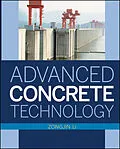Over the past two decades concrete has enjoyed a renewed level of research and testing, resulting in the development of many new types of concrete. Through the use of various additives, production techniques and chemical processes, there is now a great degree of control over the properties of specific concretes for a wide range of applications. New theories, models and testing techniques have also been developed to push the envelope of concrete as a building material. There is no current textbook which brings all of these advancements together in a single volume. This book aims to bridge the gap between the traditional concrete technologies and the emerging state-of-the-art technologies which are gaining wider use.
Autorentext
Zongjin Li is a Professor in the Civil and Environmental Engineering Department at the Hong Kong University of Science and Technology. He is the chief scientist in a study of environmentally friendly contemporary concrete, a national key project in China.
Klappentext
A detailed and in-depth guide on current state-of-the-art concrete technologies
The most common building material used around the world, concrete has enjoyed a renewed level of research and testing in the past two decades. Through the use of various additives, production techniques, and chemical processes, there is now a great degree of control over the properties of specific concretes for a wide range of applications.
The first book of its kind to focus on advanced, state-of-the-art concrete technologies, Advanced Concrete Technology serves as a practical primer on concrete's important role in infrastructure and private building construction, as well as a handy reference for building professionals seeking better understanding of its basic behaviors and continued maturation through scientific enhancement. This book includes:
-
An insightful view of the latest developments advancing concrete technologies through coverage of new theories, models, and testing techniques
-
Coverage of non-Portland cement concrete such as geopolymer concrete, magnesium-based bonded concrete, and more
-
Examination of the newest nondestructive testing methods
-
Emphasizes a materials design philosophy based on the final application of the materials
Advanced Concrete Technology aims to bridge the gap between the traditional concrete technologies and the emerging cutting-edge technologies that are refining perspectives on concrete as not only an invaluable and fundamental building material, but a versatile one as well.
Cover image is of the Three Gorges Dam located in the Yiling District of Yichang, in Hubei province, China, which is the world's largest dam. Constructed of 28 million cubic meters of concrete, it is 185 meters high and 3035 meters long and with a capacity to generate over 22,500,000 kilowatts of electricity.
Inhalt
Preface xi
1 Introduction to Concrete 1
1.1 Concrete Definition and Historical Development 1
1.2 Concrete as a Structural Material 7
1.3 Characteristics of Concrete 10
1.4 Types of Concrete 14
1.5 Factors Influencing Concrete Properties 16
1.6 Approaches to Study Concrete 19
Discussion Topics 21
References 22
2 Materials for Making Concrete 23
2.1 Aggregates 23
2.2 Cementitious Binders 31
2.3 Admixtures 68
2.4 Water 85
Discussion Topics 88
Problems 89
References 90
3 Fresh Concrete 94
3.1 Workability of Fresh Concrete 94
3.2 Mix Design 107
3.3 Procedures for Concrete Mix Design 116
3.4 Manufacture of Concrete 122
3.5 Delivery of Concrete 123
3.6 Concrete Placing 125
3.7 Early-Age Properties of Concrete 135
Discussion Topics 137
Problems 137
References 138
4 Structure of Concrete 140
4.1 Introduction 140
4.2 Structural Levels 141
4.3 Structure of Concrete in Nanometer Scale: C–S–H Structure 145
4.4 Transition Zone in Concrete 152
4.5 Microstructural Engineering 156
Discussion Topics 162
References 163
5 Hardened Concrete 164
5.1 Strengths of Hardened Concrete 164
5.2 Stress–Strain Relationship and Constitutive Equations 189
5.3 Dimensional Stability—Shrinkage and Creep 197
5.4 Durability 216
Discussion Topics 246
Problems 246
References 248
6 Advanced Cementitious Composites 251
6.1 Fiber-Reinforced Cementitious Composites 251
6.2 High-Strength Cementitious Composites 270
6.3 Polymers in Concrete 281
6.4 Shrinkage-Compensating Concrete 292
6.5 Self-Compacting Concrete 296
6.6 Engineered Cementitious Composite 310
6.7 Tube-Reinforced Concrete 312
6.8 High-Volume Fly Ash Concrete 316
6.9 Structural Lightweight Concrete 317
6.10 Heavyweight Concrete 317
Discussion Topics 317
Problems 319
References 320
7 Concrete Fracture Mechanics 326
7.1 Introduction 326
7.2 Linear Elastic Fracture Mechanics 330
7.3 The Crack Tip Plastic Zone 337
7.4 Crack Tip Opening Displacement 340
7.5 Fracture Process in Concrete 342
7.6 Nonlinear Fracture Mechanics for Concrete 346
7.7 Two-Parameter Fracture Model 348
7.8 Size Effect Model 355
7.9 The Fictitious Model by Hillerborg 364
7.10 R-Curve Method for Quasi-Brittle Materials 369
Discussion Topics 374
Problems 375
References 379
8 Nondestructive Testing in Concrete Engineering 381
8.1 Introduction 381
8.2 Review of Wave Theory for a 1D Case 394
8.3 Reflected and Transmitted Waves 403
8.4 Attenuation and Scattering 406
8.5 Main Commonly Used NDT-CE Techniques 407
8.6 Noncontacting Resistivity Measurement Method 458
Discussion Topics 468
Problems 469
References 472
9 The Future and Development Trends of Concrete 476
9.1 Sustainability of Concrete 476
9.2 Deep Understanding of the Nature of Hydration 483
9.3 Load-Carrying Capability–Durability Unified Service Life Design Theory 485
9.4 High Toughness and Ductile Concrete 487
References 489
Index 491
